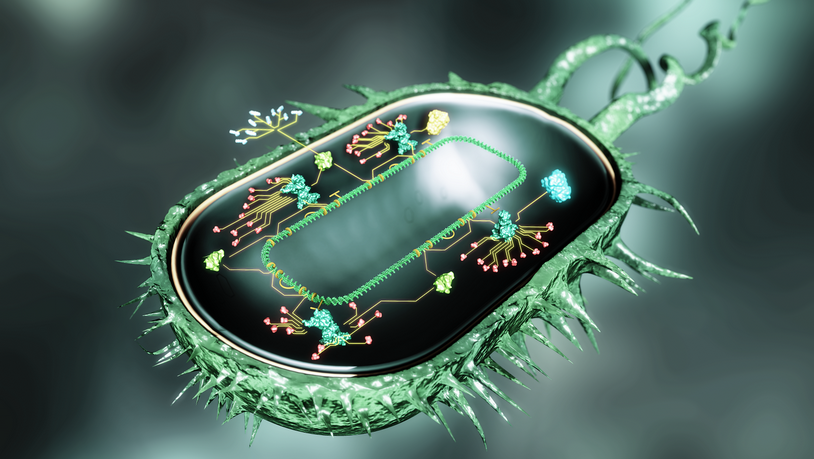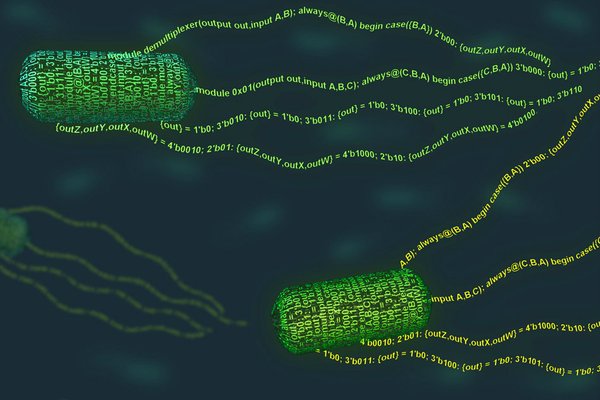Cello - living cell programming language
Welcome to the pages of the blog iCover ! The Cello software code technology developed by a joint group of scientists from the Massachusetts Institute of Technology (MIT), Boston University and the National Institute of Standards and Technology allows you to write the required set of properties into the DNA of bacteria cells and create biological circuits with the necessary logical parameters that work right inside the living cell.

The concept of Cello is based on the ingeniously simple idea that the processes occurring in biological cells of organisms can be programmed using methods similar to the computational algorithms of familiar computer systems. Using this premise, scientists were able to create a new programming language for logic elements based on nucleic acids.
Experiments already carried out by a group of researchers have confirmed the viability of the theoretical concept of “Cello” in practice. The scale of the proposed ideas and the first results obtained look very impressive. During the experiments, working biological schemes were created, consisting of sequences of up to 12,000 DNA bases based on seven basic logic elements. Using their algorithms, scientists have collected about 60 such biological schemes, 45 of which have repeatedly worked out their tasks in accordance with the program instructions. The study of the results of the first series of tests and the elimination of identified bugs allowed us to bring the percentage of correctly working schemes to 95%.
')
“Working with bacteria, you use a text-based programming language just like you program a computer or a microcontroller, but translating textual information into a nucleic acid language,” explained Christopher Voigt, a professor at the Massachusetts Institute of Technology. “The text of the original program is transformed into a DNA sequence, which is synthesized by any of the well-known and accessible methods and placed inside a living cell.” It can be said that bacteria modified with the help of Cello language literally turn into complex systems containing temperature, illumination, acidity, oxygen content and other environmental parameters surrounding the bacteria, which can be set artificially on your own.

Based on the results of the experiments, scientists can already remotely imagine how great the potential of the Cello software code is and how much problem it will help to solve globally.
One of the planned directions is the creation of complex biological systems - “stations” inside the cell, allowing it to independently find, identify and neutralize the foci of diseases by generating the currently required drug. And one of the first problems successfully solved on this path may be the problem of cancer: when programmed in a special way, the bacterial cells will be able to produce the necessary amount of the necessary medicine for local metered effects when meeting with pathological cancers.
Prospects for the use of technology "Cello" is not limited to only the medical direction. One of the many possible alternative uses is agriculture. In particular, it is allowed to treat plantings of various agricultural cultures with bacteria programmed to produce insecticides - compounds that destroy harmful insects when they are detected.
Another application of the technology is the creation of specific yeast cells that will be able to stop their own fermentation process if too many toxic by-products are formed.
Developing the idea, Voight predicts that the new language “Cello” has every chance of becoming the standard in the development of innovative biological schemes. And, importantly, the Cello algorithms will allow you to create a variety of biological schemes and then verify their effectiveness very quickly and accurately. According to the laboratory of Professor Christopher Voight, all the details of the discovery will be provided and are available for general information and use free of charge. Such a generous gift of Professor Vojta certainly inspires humanity for the benefit and, at the same time, is somewhat alarming, since it opens up free access to our biological pantry, and where, when, by whom and at what level this knowledge will be in demand cannot be predicted nor anyone else.

The results of the work are published in the April issue of the journal Science
Site of the project “Cello”
Additional source
Dear readers, we are always happy to meet and wait for you on the pages of our blog. We are ready to continue to share with you the latest news, review materials and other publications, and we will try to do everything possible so that the time spent with us will be useful for you. And, of course, do not forget to subscribe to our headings .
Our other articles and events

The concept of Cello is based on the ingeniously simple idea that the processes occurring in biological cells of organisms can be programmed using methods similar to the computational algorithms of familiar computer systems. Using this premise, scientists were able to create a new programming language for logic elements based on nucleic acids.
Experiments already carried out by a group of researchers have confirmed the viability of the theoretical concept of “Cello” in practice. The scale of the proposed ideas and the first results obtained look very impressive. During the experiments, working biological schemes were created, consisting of sequences of up to 12,000 DNA bases based on seven basic logic elements. Using their algorithms, scientists have collected about 60 such biological schemes, 45 of which have repeatedly worked out their tasks in accordance with the program instructions. The study of the results of the first series of tests and the elimination of identified bugs allowed us to bring the percentage of correctly working schemes to 95%.
')
“Working with bacteria, you use a text-based programming language just like you program a computer or a microcontroller, but translating textual information into a nucleic acid language,” explained Christopher Voigt, a professor at the Massachusetts Institute of Technology. “The text of the original program is transformed into a DNA sequence, which is synthesized by any of the well-known and accessible methods and placed inside a living cell.” It can be said that bacteria modified with the help of Cello language literally turn into complex systems containing temperature, illumination, acidity, oxygen content and other environmental parameters surrounding the bacteria, which can be set artificially on your own.

Based on the results of the experiments, scientists can already remotely imagine how great the potential of the Cello software code is and how much problem it will help to solve globally.
One of the planned directions is the creation of complex biological systems - “stations” inside the cell, allowing it to independently find, identify and neutralize the foci of diseases by generating the currently required drug. And one of the first problems successfully solved on this path may be the problem of cancer: when programmed in a special way, the bacterial cells will be able to produce the necessary amount of the necessary medicine for local metered effects when meeting with pathological cancers.
Prospects for the use of technology "Cello" is not limited to only the medical direction. One of the many possible alternative uses is agriculture. In particular, it is allowed to treat plantings of various agricultural cultures with bacteria programmed to produce insecticides - compounds that destroy harmful insects when they are detected.
Another application of the technology is the creation of specific yeast cells that will be able to stop their own fermentation process if too many toxic by-products are formed.
Developing the idea, Voight predicts that the new language “Cello” has every chance of becoming the standard in the development of innovative biological schemes. And, importantly, the Cello algorithms will allow you to create a variety of biological schemes and then verify their effectiveness very quickly and accurately. According to the laboratory of Professor Christopher Voight, all the details of the discovery will be provided and are available for general information and use free of charge. Such a generous gift of Professor Vojta certainly inspires humanity for the benefit and, at the same time, is somewhat alarming, since it opens up free access to our biological pantry, and where, when, by whom and at what level this knowledge will be in demand cannot be predicted nor anyone else.

The results of the work are published in the April issue of the journal Science
Site of the project “Cello”
Additional source
Dear readers, we are always happy to meet and wait for you on the pages of our blog. We are ready to continue to share with you the latest news, review materials and other publications, and we will try to do everything possible so that the time spent with us will be useful for you. And, of course, do not forget to subscribe to our headings .
Our other articles and events
- Netatmo Welcome Camera Review. Good Big Brother
- Spring discounts from KitchenAid
- Sale of useful gadgets and interesting pieces
- Jawbone UP3 vs. Xiaomi Mi Band 1S Pulse - the battle for our hearts!
- A selection of smart watches today. What changed?
- Spring discounts on Onkyo Hi-Fi equipment
- Logitech gives Tom Clancy's the Division
Source: https://habr.com/ru/post/392725/
All Articles